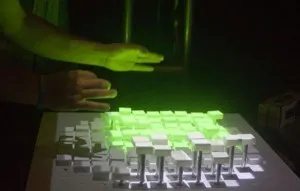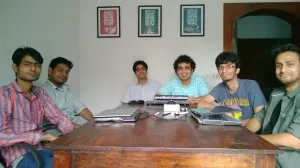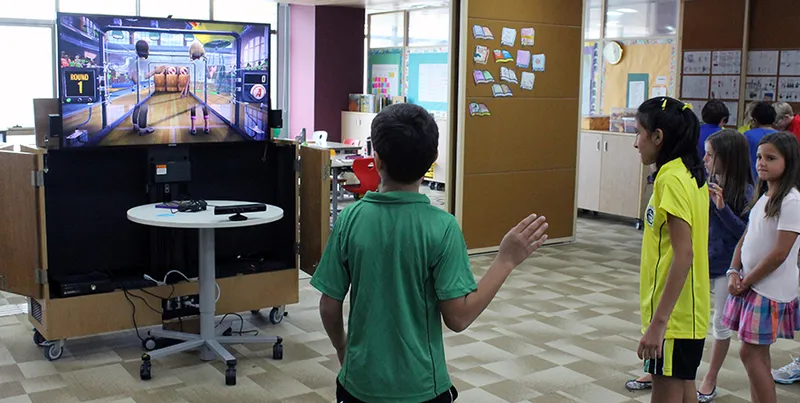Who needs buttons and onscreen menus when our hands and feet lay idle?
Switching channels is a tiring problem; imagine how Smart TV could change this. As users, we have explored gestures along with Kinect for gaming and entertainment. But beyond gaming, there is a huge market for gesture-based technologies for in education.

Back in February 2012, the NMC Horizon Report (- 2012 Higher Education Edition report) had already predicted gesture- based technologies to be in the third wave of technologies to impact learning in four to five years time.
There is a huge market for gesture-based apps to transform education because they have the potential to be used beyond being a mere medium for learning. They don't just replace one form of passive learning with another, i.e. from a textbook to an eBook, but create endless possibilities to engage the learner in a multitude of resource types and scenarios.
Why gesture-based technology is slowly gaining pace
Microsoft’s Kinect has been in the market for a couple of years now along with Nintendo’s Wii but the presence of external hardware have always been a barrier for gesture-based technologies. Soon these hardware gadgets might be replaced by smart webcams that are present on your laptops. The current webcams with advanced motion detection capabilities will act as the link to exciting future user interfaces.
Surprisingly, Microsoft is not the front-runner in this race; Intel is leading the path. Intel’s perceptual computing technology is going to be the core for gesture-based interactions. Intel also launched a camera that is focusing on real sense depth technologies. It will soon launch its Computing SDK for developers to build gesture-based apps.

Intel has also launched a $100m fund to invest in next generation perceptual based technology startups. This move will keep pumping up demands for its computer chips. This may be Intel’s last effort to revive demand for PCs, which has been lagging behind tablets. It would be interesting to see what Intel does next? The market is speculating that Intel might be working on incorporating some gesture-based sensors in the webcams.
To propel the app ecosystem for gesture-based apps, Leap Motion along with Highland Capital has setup Leap Fund. The aim of this fund is to give impetus to ideas that can grow into thriving, impactful businesses that use Leap Motion's technology. These could be companies that deploy apps in Airspace ™, Leap Motion's app store, or companies that embed Leap Motion's technology directly into hardware, services or a larger software suite outside of Airspace. There is huge potential for entrepreneurs in gesture-based technologies and Leap Fund will help entrepreneurs grow by investing in startups right from early stage to Series A.
Apple’s is also not far behind in the gesture interaction race; just recently it bought Prime Sense, the company that originally built the Kinect. This spices up the gesture game with Apple probably working on gestures in Apple TV or iPads and Macs.
Nayi Disha approach
Gesture-based learning would promote active learning methods in classrooms. Delhi-based Nayi Disha has been promoting this gesture-based learning approach by making educational games for school children with a focus on the syllabus. It’s attempting to make active student-centered approaches to classroom learning.
Kartik Aneja and Kushal Bhagia, batchmates from BITS-Pilani, Goa Campus, are the Co-founders of the company. Kartik manages the technology efforts with his expertise in gesture recognition coming from his six-month internship at HP Labs while Kushal heads the business development.
The startup is approaching this model with its specially designed curriculum that requires kinaesthetic participation from children by using Microsoft Kinect. By

weaving stories around the curriculum the child is immersed into a 3D virtual world where s/he can actively interact with the educational content by doing real world actions and gestures like jumping, running, clapping, swiping, and hopping.
The team has put together 24 Kinect-based games that cover a range of topics from the pre-school curriculum like alphabets, numbers, water cycle, comparisons and many more. They are getting good traction throughout India with close to 50 schools across 12 cities adopting their technologies.
They plan to expand now into home learning environments for kids. To validate the gesture-based market in households and to venture into this market; they have launched their Leap App - Skywriting Alphabets. To their surprise, their paid app has been bundled by Leap in their marketing tie-up with Costco. The other famous apps that are bundled along with the Leap Motion Controller are Stan Lee’s Vertices, Cut the Rope, etc.
Kushal states, “We believe we are in a very interesting space with a number of amazingly powerful natural user interface based platforms opening up. Going forward, we will continue to build great educational and child appropriate content for the Leap and the Kinect. We will also watch out for more opportunities to bring our movement-based content directly within parents’ reach.
Why gesture would work in education?
The potential of gesture technology in education is incredible. Advances have been made across many areas in order to develop gesture-recognition technology to control a wider range of devices, and educational use has not been forgotten.

Educational apps on these upcoming platforms make a lot of sense as -
1) They are extremely easy to use so there is no technology learning curve for the children
2) Movement while learning helps create a very immersive experience and has been proven to increase retention and boost engagement, especially for kinesthetic learners.
Appstore clout
Prior to the Appstore for gesture-based platform, independent developers didn’t have any prominence. These developers never got huge deals. For them to push their games on Xbox 360 or Nintendo or PS2, they either needed to have pockets full of cash or a deal with a publisher. Publishers like Activision or EA provide independent developers marketing support, funded development and launch their titles. Microsoft, Sony and others have been acting like gatekeepers to keep independent developers out.

But growing prominence of App Store has changed the scenario overall. Game developers are now most sought after among other developers. They are making millions of dollars by selling apps through various app stores. The ways of monetizing have changed over the years. From relying only on ads to now having in-app purchase and freemium models, this industry is changing rapidly.
It’s a major concern for console makers as casual games become more popular. Maximum users have started spending more on casual games for their tablets or smartphones moving away from the console games, leaving it in huge stagnation.
Microsoft is trying hard to keep developers engaged with their ID@Xbox program on their console platform by offering various baits – kits, Appstore visibility, Kinect, SmartGlass, Game DVR, in-game transactions, updates, DLC, and everything else. This means the next Rovio or Supercell could come out a hit XBOX one title because independent developers now have access to the most cutting edge tech in this space.
Read more
Pune-based Rolocule wins an award for its motion gaming technology at the ‘Oscars of Innovation’
This is going to be an amazing space to watch out for, and Nayi Disha is definately pioneering this journey in India.







